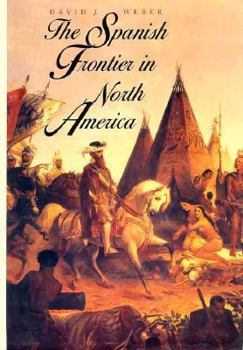The Spanish Frontier in North America
(Part of the The Lamar Series in Western History Series)
Select Format
Select Condition 
Book Overview
A compact synthesis of David J. Weber's prize-winning history of colonial Spanish North America, from the first Spanish-Indian contact through Spain's gradual retreat Praise for the previous edition:... This description may be from another edition of this product.
Format:Hardcover
Language:English
ISBN:0300051980
ISBN13:9780300051988
Release Date:September 1992
Publisher:Yale University Press
Length:579 Pages
Weight:3.35 lbs.
Dimensions:1.6" x 7.3" x 10.2"
Customer Reviews
5 ratings
Great book in a neglected area
Published by Thriftbooks.com User , 14 years ago
Being from a part of the US that is fairly unique in celebrating its French and Catholic rather than Anglo-American heritage i thought this was a great, in depth look at the Catholic European colonization of North America before manifest destiny, an area that is not well covered nationally. Although there are many legacies of the four decade long Spanish period in Louisiana like New Iberia, Spanish Lake, and family names (e.g. Romero, Ortega, etc.) much of the architecture and infrastructure that is often called French is in actuality Spanish. Because of two major fires New Orleans architecture is mostly Spanish Colonial style, and it became a really major city during the Spanish era. The Spanish language survived in the Canariano community, the Isleños, to the present day but like Acadian French its usage is limited to a few isolated areas. In all the Spanish accomplished a lot in North America despite very little immigration from the peninsula (New Spain and South America were much more attractive destinations), and a stifling mercantilist system that only began to be modified in the late 18th century. Spain was seemingly on the verge of a major rebirth in political power and culture until the accession of the weak Carlos IV and his wife's favorite Godoy who terribly bungled the response to revolutionary and Imperial France. The chaos in Spain opened the door for Anglo expansion and the rest is history, but it is intriguing to think of what might have been.
Everything you wanted to know about the Spanish colonies in North America
Published by Thriftbooks.com User , 14 years ago
This book is a thorough treatment of the Spanish colonies in what is now the United States, from Florida to Texas, New Mexico, and California. If you're looking for information on the first European colonies north of the Rio Grande, founded long before Jamestown and the Plymouth, read about St. Augustine and Santa Fe. I constantly refer to this book.
The other North American frontier, or should we say frontiers?
Published by Thriftbooks.com User , 18 years ago
Frontiers, in the plural, might be better. While many of us may call to mind Santa Fe, or the Alamo, the Spaniards were settled in, or exploring or defending, many places in North America. Only tenuously connected to each other, these frontier areas included Florida, the Gulf Coast, Texas, New Mexico, California and Arizona. While New Mexico was reachable from Chihuahua, the Llano Estacado separated it from Texas. The Sierra Madre, water supplies in Mexico and such, separated New Mexico from the late-settled California and the even more tenuous hold on Arizona, not to mention that it was easier to get to California by sailing from Mexico out into the Central Pacific then taking trade winds back ... even from the Philippines. Apaches and Yaquis separated Arizona from California. Meanwhile, the Gulf Coast and Florida weren't settled or explored from Mexico and so the first pages of their Spanish history were different. As with all the European powers, dealing with the various Indian tribes was a large part of colonization. Weber takes a careful look at this, shows how the interaction went both ways and how the Spanish at least come off better in many ways than the English. That is also to say they come off better than the English's Anglo-American descendants as well. Weber shows how Spain was less exterministic and more flexible in dealing with Indians than Anglos were, while doing so on a shoestring. None of the Spanish frontiers in today's United States had anywhere near the degree of colonization that the British colonies had; for that matter, the Spanish would have settled for the number of Frenchmen who went to Quebec and elsewhere in Canada. Meanwhile, outside of New Mexico and Florida, by the time the Spanish got into various parts of North America, the empire's administration, military prowess and economy were all on the decline. Yet, Spain persevered. Read how, and what it does, could and should mean for our country today, in this very informative book. Ironically, I bought it at Coronado National Memorial -- one of Spain's first crossings into today's United States.
Wonderful History of Spanish Colonial Frontier
Published by Thriftbooks.com User , 20 years ago
This is an excellent history of the Spanish colonial experience in North America. Like most of us, I grew up thinking of England when the word "colonial" comes around. The Spanish coolonial history is just as fascinating and far more romantic than their counterparts. Weber's history should be required reading in our universities. Anyone remotely interested in colonial history will find this a pleasant diversion.
Highly recommended
Published by Thriftbooks.com User , 22 years ago
This is an excellent study of Spain in North America, well written and superbly organized.




